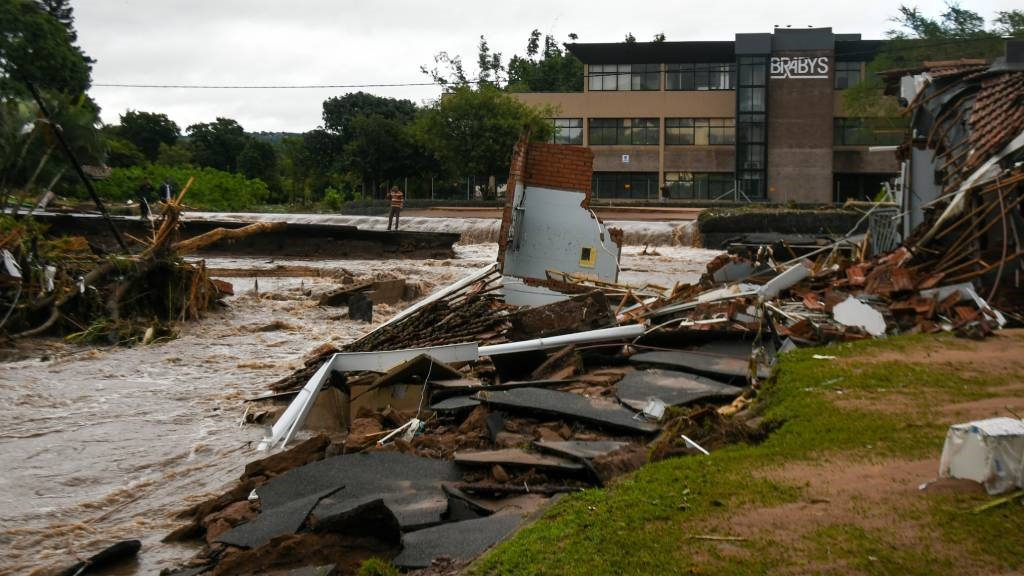

Heavy rain and floods caused havoc in Durban in 2022.
PHOTO: Darren Stewart, Gallo Images
- Twenty-three African countries are now on Google’s Artificial Intelligence (AI) Flood Hub.
- The platform monitors floods in over 80 countries across the world.
- The Artificial Intelligence behind Flood Hub draws on a variety of freely accessible data sources, including satellite images and meteorological predictions.
Twenty-three African countries are now on Google’s Artificial Intelligence (AI) Flood Hub, a platform that monitors floods in over 80 countries across the world.
This comes as flooding, due to climate change, continues to affect more than 250 million people per year, causing economic damage of at least R200 billion ($10 billion) across the world.
Yossi Matias, Google’s vice president of Engineering and Research and Crisis Response Lead, said in a statement that the application now covers some of the most flood affected places.
“As part of our work to use AI to address the climate crisis, today we’re expanding our flood forecasting capabilities to 80 countries.
“With the addition of 60 new countries across Africa, the Asia-Pacific region, Europe, and South and Central America, our platform Flood Hub now includes some of the territories with the highest percentages of the population exposed to flood risk and experiencing more extreme weather, covering 460 million people globally,” he said in a statement.
READ | Residents evacuated, roads flooded after heavy downpours in Nelson Mandela Bay
Of the 60 new countries added, eight are from Africa.
The application was launched in 2021. With more countries and improvements made, it should help in especially flood-prone regions.
“Governments, aid organisations, and individuals can use Flood Hub to take timely action and prepare for riverine floods, seeing locally relevant flood data and forecasts up to seven days in advance – an increase from last year, when information was only available 48 hours in advance,” Matias added.
The first batch of African countries to be included in the application were Angola, Burkina Faso, Cameroon, Chad, the Democratic Republic of the Congo, Ghana, Guinea, Ivory Coast, Liberia, Malawi, Namibia, Nigeria, Sierra Leone, South Sudan, and South Africa.
The latest African countries to be added are Burundi, Eswatini, Guinea Bissau, Lesotho, Madagascar, Rwanda, Senegal, and Zimbabwe.
How it works
The AI behind Flood Hub draws on a variety of freely accessible data sources, including satellite images and meteorological predictions.
The Hydrologic Model, which forecasts how much water will flow through a river, and the Inundation Model – which forecasts which areas will be affected and how deep the water will be – are then combined by the technology.
Matias said:
To be able to provide a forecast in real-time, we rely on the government we are working with. We complement their effort by adding accurate modelling to that process.
“We start by collecting thousands of satellite images to build a digital model of the terrain. Based on these maps, we generate hundreds of thousands of simulations of how the river could possibly behave.
“We receive the measurements from the government, and cross those measurements with our simulations,” said Matias in a demo video.
Then those forecasts are accessible by anyone through Search, Maps and Android notifications on Google.
Impact of floods
Extreme rains and flash flooding have damaged homes and livestock in rural Ethiopian and Somalian villages that are still recovering from a nearly three-year drought, shattering hopes for a solution to East Africa’s biggest famine crisis in decades which is disproportionately affecting children.
Want to discuss hotly debated topics with someone from across the world? Sign up for our global dialogue programme and get matched for a conversation
Flash floods in both countries claimed the lives of at least 50 people in April, drove more than 30 000 families from their homes, destroyed at least 10 000 animals and ravaged 21 000 hectares of crops, figures from humanitarian agencies show.
Still, in April, several districts in Rwanda’s Western Province experienced immense suffering due to flooding brought on by excessive rains.
A reported 127 people died as a result of the flooding and mud slides.
In Southern Africa, Zimbabwe, Mozambique, Malawi and parts of Zambia recorded cases of cholera and malaria.
In most countries, cholera and malaria outbreaks are attributed to flooding due to seasonal rains and tropical cyclones.
The News24 Africa Desk is supported by the Hanns Seidel Foundation. The stories produced through the Africa Desk and the opinions and statements that may be contained herein do not reflect those of the Hanns Seidel Foundation.
